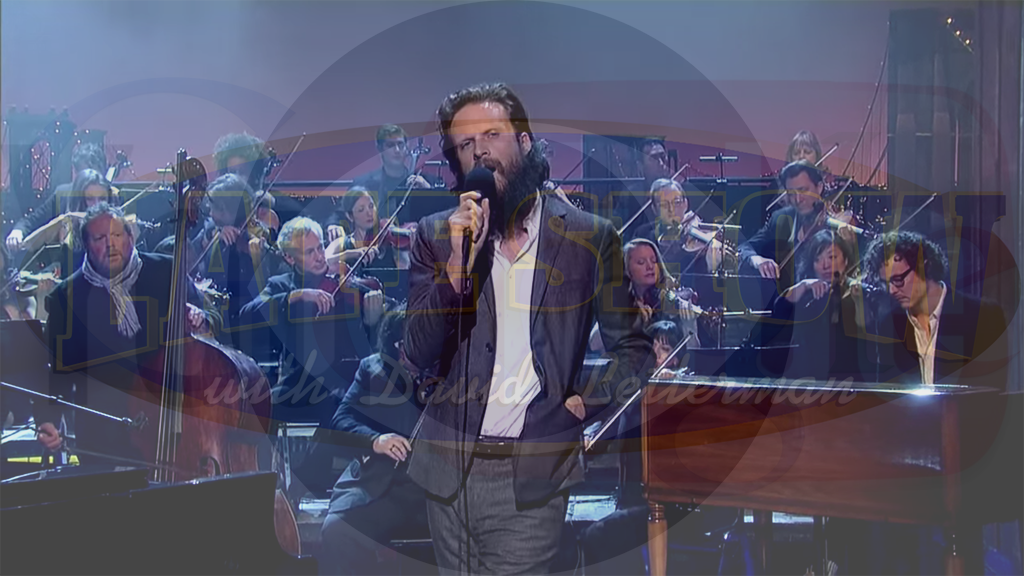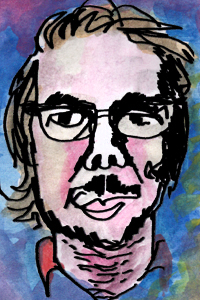 This — Father John Misty performing “Bored in the USA” on Letterman — happened in November of last year, and only through a confluence of influences, too multifarious to outline here, did I even have cause to look it up. So I have arrived at it once the initial promotional ruckus has subsided.1 What I mean to say in this piece is pretty embryonic; I am, to a certain extent, talking Father John Misty (J. Tillman) as a musician/artist/beard-enthusiast/social-commentator, though this is really to facilitate something else. Similarly, the specific mechanics of the performance are somewhat important to get to this something else, rather than say performance qua performance. I really want to talk about it as a little cut-up piece of TV, thrown up online and used to promote an (becoming) anachronistic media format and from that extrapolating to what that might point to in wider discussions. Discussions about modes of expression, aesthetics, society, politics, ennui, etc. But to get there the media sort of piles up, in a way that is important to investigate.
This — Father John Misty performing “Bored in the USA” on Letterman — happened in November of last year, and only through a confluence of influences, too multifarious to outline here, did I even have cause to look it up. So I have arrived at it once the initial promotional ruckus has subsided.1 What I mean to say in this piece is pretty embryonic; I am, to a certain extent, talking Father John Misty (J. Tillman) as a musician/artist/beard-enthusiast/social-commentator, though this is really to facilitate something else. Similarly, the specific mechanics of the performance are somewhat important to get to this something else, rather than say performance qua performance. I really want to talk about it as a little cut-up piece of TV, thrown up online and used to promote an (becoming) anachronistic media format and from that extrapolating to what that might point to in wider discussions. Discussions about modes of expression, aesthetics, society, politics, ennui, etc. But to get there the media sort of piles up, in a way that is important to investigate.
First a brief note on the song, for those new to it. This is from FJM’s most recent album, and this particular track has been called satirical by numerous commentators, largely due to its lyrical content (rather than funny sounds or samples). For example, from the chorus:
I’m just a little bored in the USA
Oh just a little bored in the USA
Save me white Jesus
Bored in the USA

Macon Holt is an academic cultural theorist, writer, and musician. He writes a monthly column for Full Stop on pop music as a utopian political project.
Often satire is merely a cathartic release for the converted. A way in which to confirm your own beliefs, in the company of a like-minded virtual community, and simultaneously ridicule your opponents. Theodor Adorno thought that catharsis was a major mechanism of the culture industry in the reproduction of capitalism, as the “substitute satisfaction” of catharsis satiated the public’s desire to struggle for change. And, for sure, you can certainly get that out of this song, especially on lines like “Save me President Jesus”, easy lines to flatter the American left3 as another amorphous concept. If this were entirely the case, if satire only serves to relieve suffering, then it would be an extraordinarily conservative pursuit. However, satire can be constructive if you accept, along with Žižek, that far from irony or cynicism being opposed to sincerity, irony and cynicism allow for the expression of sincerity in the particular conditions of our age.
As a former member of Fleet Foxes, Tillman, with his prescription-length, hip beard, retro tight fitting clothing, and music sonically influenced by nostalgic Americana, is laden with the baggage of painful earnestness. This could lead an ungenerous listener to dismiss the song as hipster whining, which to a certain extent, it is. But in the Letterman performance this gets gradually undercut. After the first verse, during which Tillman appears to be playing the piano, he turns away from the keyboard and the camera reveals the piano is playing by itself. With this we get some points for recognising the artifice of the media event; the artificiality of whatever Letterman presents. However, once we reach the chorus and Tillman is lamenting his boredom, sitting atop the piano like a lounge singer, before raising to his knees to ask for salvation from “white Jesus”, he has included himself as a target of ridicule too. The satirical elements of the song are no longer directed solely at Tillman’s opponents but, beyond the textual self-loathing of the second verse, he starts to attack his own delivery of the message and the medium by which he is presenting it; the TV performance of the earnest social comment ballad. This becomes even more complex as the performance moves to the bridge.
They gave me a useless education
And a sub-prime loan
On a craftsman home
Keep my prescriptions filled
And now I can’t get off
But I can kind of deal
On the record, after the first line canned laughter is mixed in. This increases in intensity with each line before becoming rapturous laughter applause as the chorus returns. This section becomes a set of one liners, of which Tillman’s sincerity — his comments on the political, social, and personal strife of contemporary America — is turned into the punchline. This allows us to see how the power of these images (that the lyrics point to) is instantly snuffed out by the laughter of an audience hungry for cathartic release. In other live performances this laughter track is left off, and the song is significantly weaker for it. But on Letterman it’s there and this is where, regardless of whatever Tillman’s original intention for the laughter (perhaps as getting-there-first, ironic defence), we are able to witness the defanging of content-based critique as just that — a defanging. This is not the studio audience — you can hear them distinctly at the end. This is laughter being played to the audience.
Since his first book in English, written in the late ’80s, Žižek has been making the argument that canned laughter helps to fulfil the duty of the consumer to laugh and enjoy at the products of late capitalist entertainment, even if they are exhausted or don’t find them funny. And this is a compelling argument; especially true in the ’80s and ’90s. Try watching a repeat of Friends4 with the volume on low, so you can’t hear the dialogue, just the laugh track. The laughter is almost rhythmic, like it fits to a scene-based metric rather than the more organic subtleties of performance, which can be heard, for example, on The Daily Show. It feels like a 20-minute evening ritual. In “Bored in the USA”, however, the laughter is literally rhythmic, drawing attention to its qualities of artifice, consumer duty, and supplement.
This gets even more interesting on YouTube, as the clip in its discrete form contains both the canned laughter and the applause of an audience that it is now, unlike a TV broadcast, impossible to argue we are a part of as they are in the artifact. When we watch a clip of the Late Show, especially one posted officially, we aren’t watching the Late Show, we are watching a taster often intended to promote the idea that it would be great to watch the Late Show; listen to that audience, they’re having such a great time. But then we watch a performer play, to an audience, a mimetic form of the audience’s own laughter. We are the audience of that media. This is what makes me think that in the instance of the Late Show performance, Tillman has done more than only cover his own appearance of naivety and sincerity (though as Žižek might argue, this may just be how we express these ideas in a way that seems genuine), rather the potential is there for these satirical remarks to perhaps haunt a wide audience as he beats them to their own ironic response.
This isn’t going to change the world, but it’s pretty interesting to see a subtle device of audience critique, usually left in the wilderness of the art world (in the work of David Lynch in Inland Empire or the opening of Michael Haneke’s Amour or the fantastic Inaugural Address by Andrea Fraser) on mainstream late-night TV. What can be seen here, on this extra medial layer, as the major media institutions have firmly arrived on Google-owned YouTube, is perhaps the beginnings of the end of the cultural stasis supposedly ushered in by full saturation of mass media and the postmodern condition. This is not to say the internet will save us all. It is just a tool, a tool that, in this case, allows us to see more in what media institutions produce. What can perhaps be seen here as the laughter kicks in, and Tillman shrugs and sings with sonic sincerity, is the opening up of a space where irony and sincerity can co-exist, adding complexity to satirical expression that may move beyond a mere cathartic functionality. But I don’t know what that will look or sound like yet.
1. Though, in the spirit of full disclosure, to a certain extent that is still functioning.
2. If, and only if, they were to 1) pay any attention to someone who is still a relatively obscure artist, though he would be a useful background tone for that whole malapropism of the ‘liberal’ media spiel, and 2) detect the irony.
3. Though some what harder to fit with what has been called by some “bearded earnestness“, the fraught expectations of a limited notion of ‘authenticity’ expected of contemporary singer songwriters.
4. Which had a live audience, and that is the weird thing.
This post may contain affiliate links.







